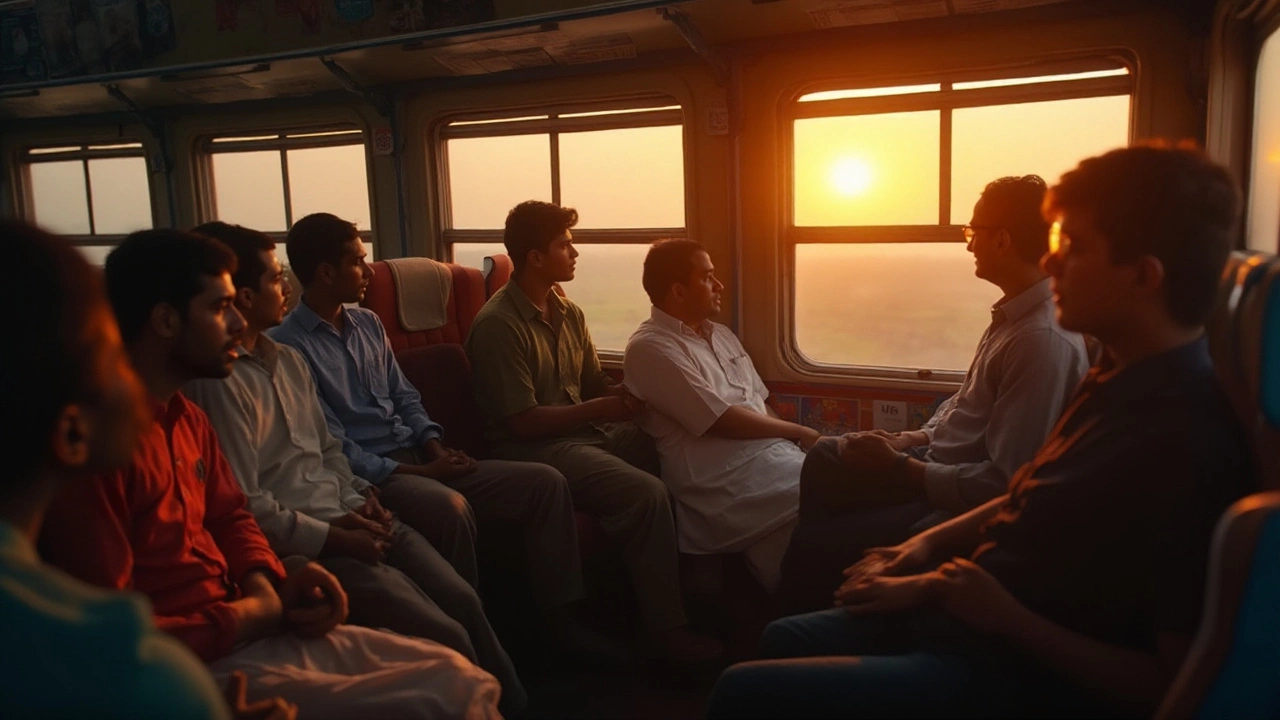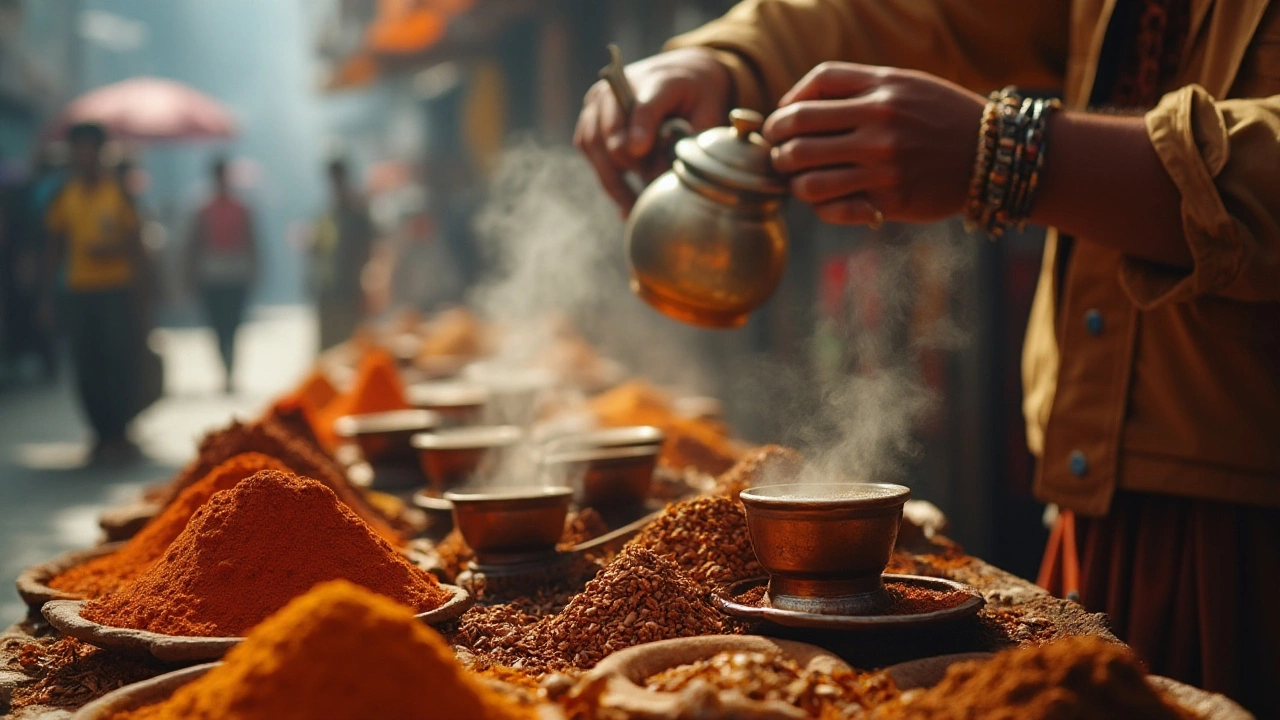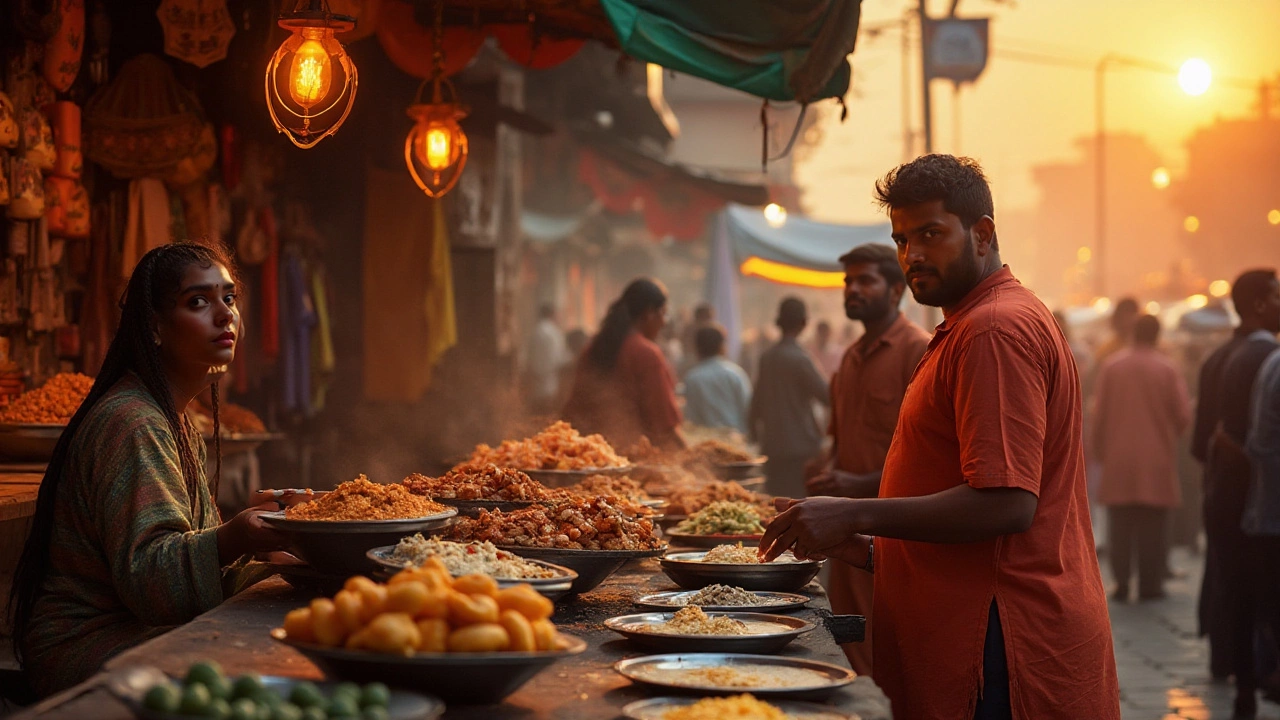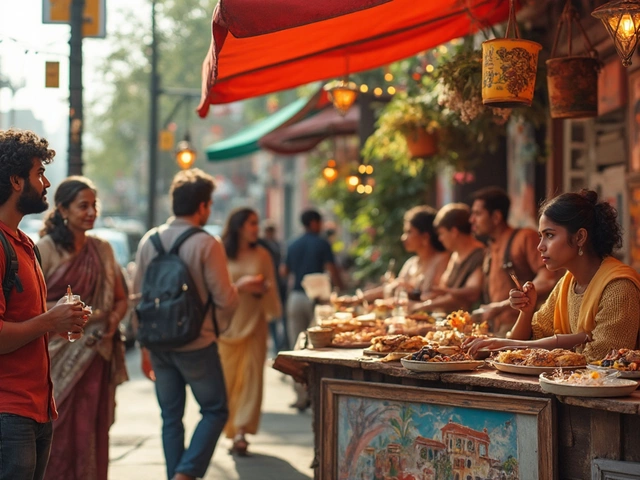Traveling on a budget in India can be a delightful challenge and an enlightening experience. When you have just one US dollar in your pocket, figuring out where it can take you in this diverse country is part of the adventure. Known for its vibrant culture and dynamic contrasts, India offers experiences that are both rich and affordable.
Diverse in language, cuisine, and lifestyle, every state offers something unique that can make your one dollar stretch surprisingly far. From savouring spicy street food and cruising through bustling city streets in an auto-rickshaw to exploring affordable heritage sites, each dollar spent here can unfold a new story for the wandering soul.
- The Value of a Dollar in India
- Budget-Friendly Street Food
- Affordable Public Transport
- Cultural Experiences on a Budget
- Shopping for Local Goods
- Staying Connected: Internet and Mobile Options
The Value of a Dollar in India
Understanding the value of a dollar in India is like peering through a fascinating lens that blends economics, culture, and daily life. For an American, the exchange rate can be both thrilling and bewildering, primarily because one US dollar, approximately equal to 80 Indian rupees as of the last recorded year, can usher you into a realm of varied experiences. Imagine a bustling marketplace in Delhi or a serene beach in Goa, and picture the modest spending power of a single dollar. It's surprising how far it can reach.
One of the key sectors where your dollar really shines is in the food industry. India is renowned for its street food – an avenue where the burgeoning traveler can taste authentic flavors without draining their wallets. For less than a dollar, you can savor a plate of crispy 'samosas' or a steamy cup of 'chai,' mingling with locals in an atmosphere that is both lively and culturally enriching. A report from Lonely Planet highlights that India offers one of the most affordable street food experiences worldwide, a testament to how foreign currency can yield genuine culinary adventures without hefty costs.
"In India, one US dollar goes a long way, particularly in street markets where prices are often negotiable," shares Alex Robinson, a travel journalist with extensive experience in South Asia.
But it's not only about food; public transportation in India is another area where a dollar becomes your trusty sidekick. With options ranging from cycle rickshaws to metro train rides, getting around major cities like Mumbai and Kolkata is feasible on a tight budget. The metro fare in Delhi, for instance, starts as low as 10 rupees, making it possible to traverse the city several times and still have change left from one single dollar.
| Items | Cost in Indian Rupees (INR) |
|---|---|
| Local Metro Ride | 10-30 INR |
| Street Food Snack | 20-50 INR |
| Local SIM Card | 50-100 INR |
For those with an appreciation for authentic hands-on experiences, a dollar in India can also buy a few fascinating experiences that are uniquely indicative of Indian culture. With an affordable fare, you might visit a local temple or join a community art class in vibrant cities. Often, these experiences are not only economically reasonable but also enrich your understanding of India's societal fabric. A simple gesture like buying a local craft item not only supports artisans but also enhances your travel story with a souvenir carrying the spirit of India.
Budget-Friendly Street Food
Street food in India is not just about sustenance; it’s about savoring culture with every bite. Across bustling markets and quiet alleys, vendors serve a colorful array of flavors and dishes that can be experienced on a budget. With just a single US dollar, you can indulge in several street food specialties, offering a taste of India that high-end restaurants often cannot rival. From spicy treats to sweet surprises, the streets transform into a gourmet expedition for budget travelers.
One iconic offering is the 'chaat', a savory snack assembled with an enticing mix of crispiness and tanginess. Found bustling within the busy lanes of Delhi, this dish is made with fried dough, potatoes, chickpeas, and vibrant chutneys. For less than a dollar, you can enjoy this in one of the many roadside stalls known to offer mouth-watering snacks. Every bite offers an unexpected thrill of spicy, sour, and sweet flavors that complement each other perfectly, making it irresistible and easy on the pocket.
Vada Pav from Mumbai, often dubbed the city’s own burger, is another infamous treat that travelers can enjoy without straining their wallets. This simple yet flavorful snack consists of a spicy potato filling deep-fried in gram flour batter and served with chutney in a bun. At a price not exceeding a few rupees, it’s an absolute must-try, offering nutrition and indulgence wrapped in simplicity. An excellent choice for time-strapped explorers wanting to capture a taste of Mumbai’s renowned street food culture.
Sweet Tooth Adventures
Sweet lovers aren’t left out either. With 1 US dollar, you can relish 'jalebis', deep-fried spirals of flour dough soaked in sticky sugar syrup, often enjoyed hot. Locations like Jaipur and Ahmedabad offer fresh jalebis straight out of the wok, delivering a sugary explosion with each bite for a fraction of the cost you might expect for such decadence. Another sweet delight, 'Gulab Jamun', melt-in-mouth milk solid balls soaked in syrup, can offer a delightful conclusion to your budget culinary journey. Each piece is a testament to Indian confectionery expertise where flavor meets affordability.
In 2016, a study noted that India was the third-largest consumer of street food globally, indicating the cultural significance and popularity it holds.
“Street food isn’t just about the meal, but the interaction, the vibe of the streets, the shared laughter over a bowl of golgappa,” shared renowned chef Ranveer Brar. “It connects you to the roots of a city, in the most unique way.”
For adventurers yearning to explore local flavors without splurging, India's street food scene promises endless discoveries. From north to south, east to west, this budget culinary map offers a taste for every palate. Embrace these low-cost, high-flavor encounters, and let your taste buds journey through an authentic Indian escapade, without breaking the bank or the soles of your shoes.

Affordable Public Transport
When traveling through India on a budget, you'll quickly discover that the country offers a range of affordable public transport options that make exploring its vast landscapes both accessible and exciting. The extensive network of buses, trains, and auto-rickshaws not only connects major cities but also reaches into the heart of rural villages. This network is a crucial element of daily life in India, relied upon by millions for their commutes, and it can be a fascinating way to immerse yourself in the local culture. An auto-rickshaw, commonly referred to as a 'tuk-tuk,' offers a quintessentially Indian travel experience. These three-wheeled vehicles are abundant in urban areas and can be hailed off the street in a manner reminiscent of a taxi. Fares are typically negotiable, allowing you to practice your bargaining skills and secure travel for just a portion of a dollar when covering short distances. Remember to agree on a fare before hopping in, as meters might not always be used or trusted.
India's railway system is an adventure in itself, with its charm woven into the fabric of the country's history and development. Indian trains are not only among the cheapest modes of transport but also among the most scenic ways to traverse the landscape. Whether embarking on a long overnight journey or a short commute, Indian Railways offers a variety of classes to suit the budget-conscious traveler. A few rupees will secure a seat in the general class for short hauls, where you'll undoubtedly engage with locals, sharing conversations and perhaps snacks. Longer journeys might be best tackled in sleeper class, where, despite the basic accommodations, you'll find plenty of fellow travelers to exchange stories with. Make sure to book in advance during popular travel seasons.
Next, consider the local bus system, which can vary dramatically from state to state, but consistently offers some of the lowest fares in the world. City buses are a staple in urban environments, offering convenient routes to popular destinations and local attractions. In rural areas, these buses are lifelines, linking isolated communities to larger towns. While rides might be crowded, they're often lively, providing a snapshot of daily life beyond the tourist trail. Fares can start from as little as a few rupees and rarely exceed the budget of a backpacker. Connectivity is improving with apps and online bookings making transport more tourist-friendly.
Sometimes, understanding the intricacies of public transit in a foreign country can be intimidating. However, in India, the affordability and cultural immersion far outweigh any initial confusion. As Andrew Lawrence, an expert in budget travel, succinctly put it,
"Exploring India's railways and bus systems isn't just about getting from point A to point B; it's about becoming a part of the world's most vibrant tapestry of human life."This sentiment echoes the heart of travel, turning each journey into part of your adventure story. While planning, take a moment to explore available resources such as digital platforms and forums where travelers and locals share tips and current fare rates.
Cultural Experiences on a Budget
India, with its kaleidoscopic array of cultures and traditions, offers travelers an infinite sea of cultural experiences that won't break the bank. Whether you're wandering through the bustling streets of Mumbai or exploring the serene temples of Varanasi, you'll find myriad ways to immerse yourself in the local culture. A single US dollar might not seem like much, but when spent wisely, it opens doors to unforgettable memories in this vibrant land. Attending a local festival can be one such doorway. From the colorful chaos of Holi to the lights of Diwali, each festival has its own spirit and grandeur. Joining the revelers costs little more than your time and curiosity. If you find yourself in Kolkata during Durga Puja, for example, the city comes alive with melodious music, traditional dances, and intricate idols, letting you sample the local culture simply by being present.
Besides festivals, another budget-friendly cultural venture is visiting local temples and historic monuments. Temples are not just spiritual sanctuaries but also offer a glimpse into the architectural prowess and historical narratives of India. Entry to many of these sacred sites is free or nominally charged, making it easy for budget travelers to explore. Ancient temples like the Sun Temple in Konark or the intricately carved structures of Khajuraho can be both a cultural and meditative experience, enriching your travel at little cost. Even the Taj Mahal, one of the world's most iconic landmarks, has entry fees that vary greatly for locals and foreigners; however, the view from the rear edge of the complex across the river Jamuna is free and arguably just as mesmerizing, especially at sunrise or sunset.
If art is your muse, then India won’t disappoint with budget-friendly cultural workshops that allow you to try your hand at traditional crafts. You can learn about block printing in Rajasthan or pottery in a rural village, often for less than a cup of coffee back home. Such workshops provide not just an immersive cultural experience but also allow travelers to take a piece of the local culture back with them, quite literally in the form of handmade souvenirs. As cultural engagement becomes more about interaction rather than observation, workshops create a deeper connection to the places you visit. Many of these workshops are initiatives by local families or NGOs, supporting sustainability and community development. Participating thus supports local artisans who maintain their crafts amidst modern challenges.
"Travel not merely to see, but to be part of the fabric of another culture," a sentiment echoed by renowned travel writer Pico Iyer, aptly summarizes this immersive form of experiencing culture.
Traveling across India also means indulging in its vast culinary diversity as a form of cultural exploration. With a dollar, you can sample street foods like vada pav in Mumbai or chai in Delhi, known not only for their flavors but also for the stories they carry. Street markets and local eateries are culinary windows into the region's soul and require only a few coins to fill both your stomach and your senses. Of course, it goes beyond just eating; conversations over meals often introduce you to the warmth of Indian hospitality and an insider's look into local lifestyles. Even when your budget is tight, striking up a conversation with a vendor over a coconut or a cup of tea can lead to fascinating insights and connections that no guidebook can provide. Such exchanges have the potential to highlight the stories behind the ingredients, methods, and traditions that shape the delectable landscape of Indian cuisine.

Shopping for Local Goods
In India, shopping can be a sensory adventure like no other, where lively bazaars and quaint markets overflow with an array of colors, textures, and sounds. For those traveling on a budget, exploring these markets can yield incredible finds that don't break the bank. Each region showcases its unique array of local goods, from handwoven textiles and traditional clay pottery to intricate jewelry and aromatic spices. Often, these treasures represent a storied craft handed down through generations, giving each item a soul and a backstory.
One of the most exhilarating experiences is bartering with shopkeepers in bustling markets like Delhi's Chandni Chowk or Mumbai's Colaba Causeway. Here, one can find everything from vibrant silk scarves to handmade leather goods. With about 82 Indian Rupees to a US dollar, these markets offer plenty of opportunities to indulge in the art of negotiation while hunting for affordable souvenirs. Remember that the price initially mentioned is often negotiable, and a friendly back-and-forth can result in a rewarding deal for both vendor and buyer. As one experienced traveler notes, "The joy of shopping in India's local markets lies not just in the items you take home but in the interactions that breathe life into them."
An important aspect of shopping in India is supporting local artisans who maintain traditional crafts despite the encroaching tide of mass-production. Khan Market in Delhi, though known for its upscale shops, also features stalls where you can purchase handmade items while directly contributing to the local economy. Additionally, attending events like the annual Surajkund International Crafts Mela near Delhi can offer a glimpse into India's diverse handicrafts and an opportunity to support the artisans behind them. For those with a culinary bent, the smell of freshly ground spices from Kolkata's century-old New Market is irresistible, and a few dozen rupees can buy a substantial bag of masalas to spice up your life back home.
Budget-savvy travelers seeking an authentic Indian shopping experience should dive into street markets scattered across small towns and rural areas. Many of these places are excellent for picking up traditional village crafts or edible treats. Be it the hand-loomed fabrics of Tamil Nadu or stone-carving handiworks of Odisha, these smaller markets offer a plethora of possibilities for just a few US dollars. To gain a deeper understanding of the artistry behind certain products, some workshops allow visitors to observe craftsmen at work, offering perhaps the most tangible link between object and creator. The cultural richness this insight brings is priceless.
Here’s a little tip: carry small denominations of the local currency. Vendors in these settings appreciate the ease of making transactions without the hassle of finding change for a large bill. It's a simple gesture that can make your market trips smoother and more enjoyable. Whether you're seeking practical goods or charming keepsakes, shopping in India paves the way for memorable interactions and a chance to pick up beautiful, locally-made items without draining your travel funds. In a country as vast and varied as India, a dollar spent on the right souvenir can indeed be worth a special place in your travel memories.
Staying Connected: Internet and Mobile Options
In today's fast-paced world, staying connected while you travel is not just a convenience but a necessity. Whether you're updating your travel blog, staying in touch with family, or navigating through cities, mobile data and internet are crucial. India, with its rapidly growing tech infrastructure, provides several budget-friendly options for travelers looking to stay online. With the availability of affordable SIM cards and widespread Wi-Fi access, staying connected is quite straightforward.
Purchasing a local SIM card should be one of the first things you consider upon arrival. Telecom shops are typically found in airports, train stations, and city centers. The top service providers in India include Airtel, Jio, and Vodafone-Idea, with Jio offering some of the most competitive rates in the market. For instance, with just 99 Indian Rupees, roughly equating to 1 US dollar, you can get a prepaid plan with 1GB of high-speed data per day and unlimited calls for a validity of 28 days. This ensures you have ample data for social media, maps, and light browsing needs.
When it comes to Wi-Fi, most hotels, cafes, and public spaces in urban centers offer free access. A little advance research can help locate many cafes and co-working spaces that feature reliable connections. For travelers snapping shots on the go, uploading images and sharing experiences live can be done without breaking the bank. Though speeds might vary, especially in more rural areas, urban locations generally boast reliable internet services.
"In India, a dollar goes far in connecting you to the world. With cheap data plans, you’re never too far from a Google search or your next Instagram post," remarked a seasoned travel blogger in a recent interview on mobile connectivity in India.
For those needing a constant connection, an important aspect to weigh is the roaming agreements between local providers and international companies. Opting for an international roaming plan with your home country’s carrier might seem convenient but is often pricier compared to local options. A little patience at a local store could save significant expenses and make your trip more enjoyable without tech hassles. Budget travel India becomes simpler when technical challenges are kept at bay and connectivity barriers minimized. Always ensure you're aware of associated charges for international calls and messages, although apps like WhatsApp or Telegram typically bypass these costs when used over data.



